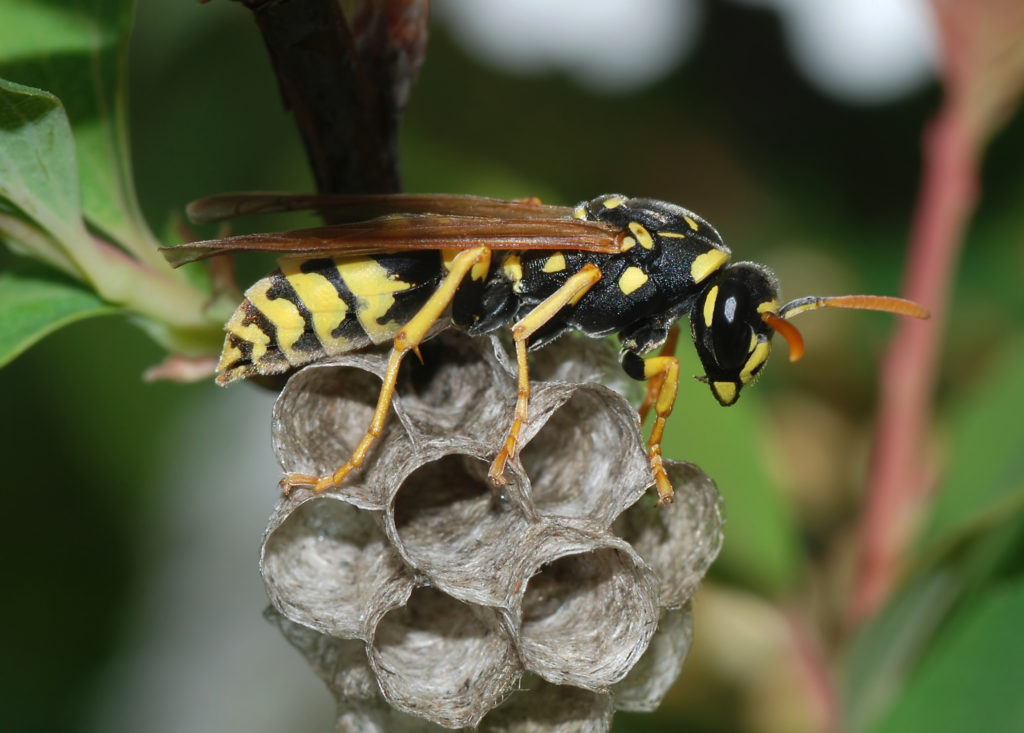If you have seen some bugs flying around and think you have wasps, it’s time to act. These insects could not only sting you and your loved ones, but they may also infest a home or building if left untreated. The following includes some tips on how to identify and deal with wasps.

Identifying Different Types of Wasps
There are thousands of different wasp types in the United States. Most of the wasps that appear in or near homes are the social type that travel together. These insects usually have think waists, which differentiates them from bees. They have far less body hair than bees. They live in colonies, though these communities are generally smaller than bees. There are three major types of wasps home owners can expect to see: hornets, yellow jackets, and paper wasps.
Hornets are the most common species of wasps that exterminators see in the United States. They have papery nests and white markings on their head and body. These stings are painful, though hornets are aggressive unless they feel threatened.
Yellow jackets are aggressive wasps. They have shorter legs than the paper wasp and black antennae. They usually build their nests in the ground or in walls with gaps.
Paper wasps can be larger than hornets, growing to be 16-20 millimeters long. They are brown with yellow or red markings. What makes them even more distinct is their long legs.

Detecting an Infestation
The first sign that there may be a wasp problem is if you see them inside of a home or flying around an entrance. Take some time to look for nests. If you spot a nest, then you definitely have an infestation because the insects have made their home.
Nests look papery because they are comprised of chewed wood or mud. They usually build these nests in the spring, and if you do not act quick enough eggs will be paid and worker wasps hatch. To find a nest, watch where wasps fly. You can find nests near roofs, window shutters and near garden sheds.
Getting Rid of Wasps
Wasps can be dangerous, especially if they have built their nest near your home. You do not want to get stung. Professional exterminators know how to find and treat wasp nests to protect the home and get the job done right the first time.
There are different ways to control wasps: from removing the nest, making traps, or blocking entry into a nest. Home owners should also take care to keep a home clean and avoid leaving food outside. This includes things like cat food or even bird feeders.
Keep Them Outside the Home
Wasps enter a home if there is an opening, so it is important to keep windows closed and to close up any gaps in window sealings, etc. A common issue during the winter months is that wasps find a way into the home near the roof and build nests in attics. Yearly inspections of your home will help you spot any possible entry-points for insects of all types.
Since queen wasps look for places for their nests in the spring, home owners should be aware of this. At the first sign of a nest, it is important to call professionals in to handle this. Full-fledged wasp nests usually pop up in the middle of summer. If a nest has lasted until the fall, the insects may start looking for ways into the home. Knowing the time of year helps home owners be extra vigilant.
Do It Yourself Extermination
Though it is not recommended to try and remove or deal with a wasp nest yourself, there are some safety things to consider if you do make this decision. For example, one should try and wear protective coverings in case the wasps leave the nest and try to attack the home owner.
Next, professional recommend treatment happening at night since you can be sure all of the wasps, including the queen, are in the nest. Removing the nest is not enough since the remaining wasps can simply rebuild their nest. Home owners can investigate different spray options too to keep these insects away. After do it yourself treatment or professional extermination, home owners should be on the lookout for remaining wasps.
Though wasps have benefits for the environment, they can be dangerous for a family. After all, these insects can sting, and some people have allergies to them. Staying aware and noticing when they are around helps home owners deal with this issue. If you see a nest, try to avoid it until it is treated. Otherwise, you could be putting yourself in danger.
For more information about our extermination services in Montreal or tips about how to deal with a wasp infestation, contact us today!